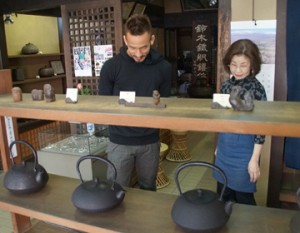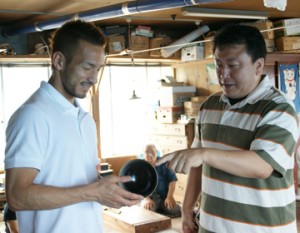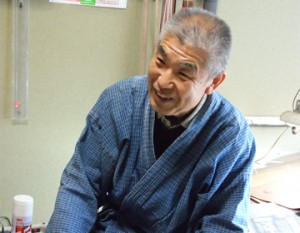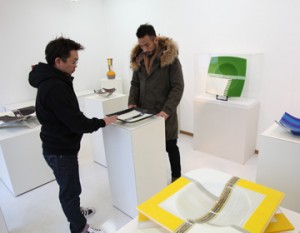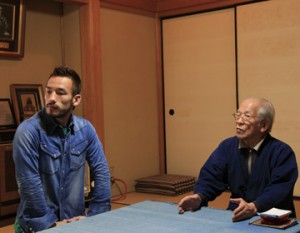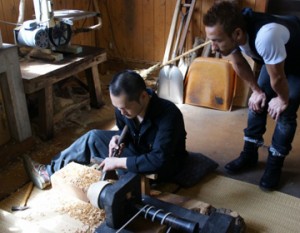Designs from abroad being incorporated into Japanese tradition
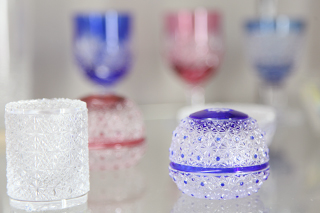
There are rules to the patterns of Edo Kiriko. “There are approximately 10 types of standard geometrical designs,” explained Toshiro Kobayashi. He is a third generation Edo Kiriko artisan, taking after his father and grandfather.
“We usually use the existing patterns though there are some who have their own unique designs. The new designs are rarely commercialized and hardly ever referred to as “Edo Kiriko”, while there may be distinct, single pieces.”
According to Kobayashi, the geo geometric designs of Edo Kiriko originally came from Europe, where glass art was popular. The cutting technique was especially popular in Ireland and England from where most of the patterns were adopted. Slight Japanese style alterations were made, leading to the “Edo kiriko” we are familiar with today. It has since flourished becoming a unique form of Japanese art. There used to be many old patterns like those seen in Satsuma Kiriko pieces.
The Old and the New
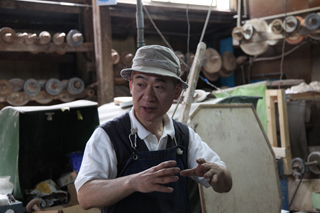
Kobayashi’s family has produced generations of Edo Kiriko artisans. Currently the son, Shohei Kobayashi, is the 4th generation, so there are many old tools that have been handed down in the family.
What has changed drastically over the years is finishing polish process. We were invited to see their workshop where we saw many old polishing stones, which had been used to polish the glassware by hand. Hand polishing took a lot of time and involved many steps. This all changed with the appearance of the diamond disc. It decreased the polishing process to a single step, and shortened the time by a quarter.
“When equipment takes over an artisan’s job, the artisan’s skill declines, not that that is always bad. It is also true that without using new tools, we would not be able to continue our work.”
Currently, there is another polishing method in addition to hand polishing and polishing with a diamond disc. Polishing with acid. There was a time when people said that it was not true Edo Kiriko unless everything was by hand. However, Kobayashi told us that the acid polishing method existed from the Taisho period. So this is a misunderstanding.
New technique is incorporated into traditional craft making. This is a challenge that traditional crafts face and need to overcome every so often. At Kobayashi’s studio, we saw the Edo Kiriko that had gone through these changes.
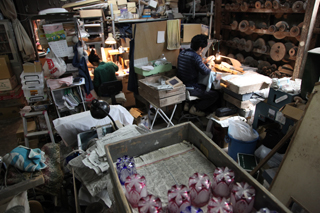
The corners do not fit…
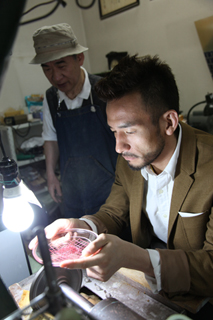
The most prominent feature of Edo Kiriko is the geometrical patterns with large grids. As a work of art, it is ”beautiful”, but when you have to create it, it is ”difficult”. Nakata experiences this first hand.
”Sand this until the red line disappears.” Nakata tries to scrape the glass against the disc as he was instructed, but it is not a simple task.
”No matter how I do it, the lines aren’t even.” Nakata said in dismay. The corners of the grid pattern don’t match because the width and depth of the lines are not uniform. This will not create an attractive Edo Kiriko. ”This can only be mastered with experience.” Kobayashi told us. It was said that it takes 10 years for someone to master a skill. Of course these techniques cannot be learned overnight. But these skills are what brings out the beauty of Edo Kiriko.
Currently there are 59 companies in Tokyo that create Edo Kiriko. Most of them only have one or two artisans. Kobayashi says that there are obstacles they need to overcome as demand decreases. Glassware tends to be considered expensive, and it takes time to nurture an artisan. Traditional craft that is passed on in Edo, Tokyo. Edo Kiriko with its stylish beauty. Kobayashi shared the issues they face for the future.





